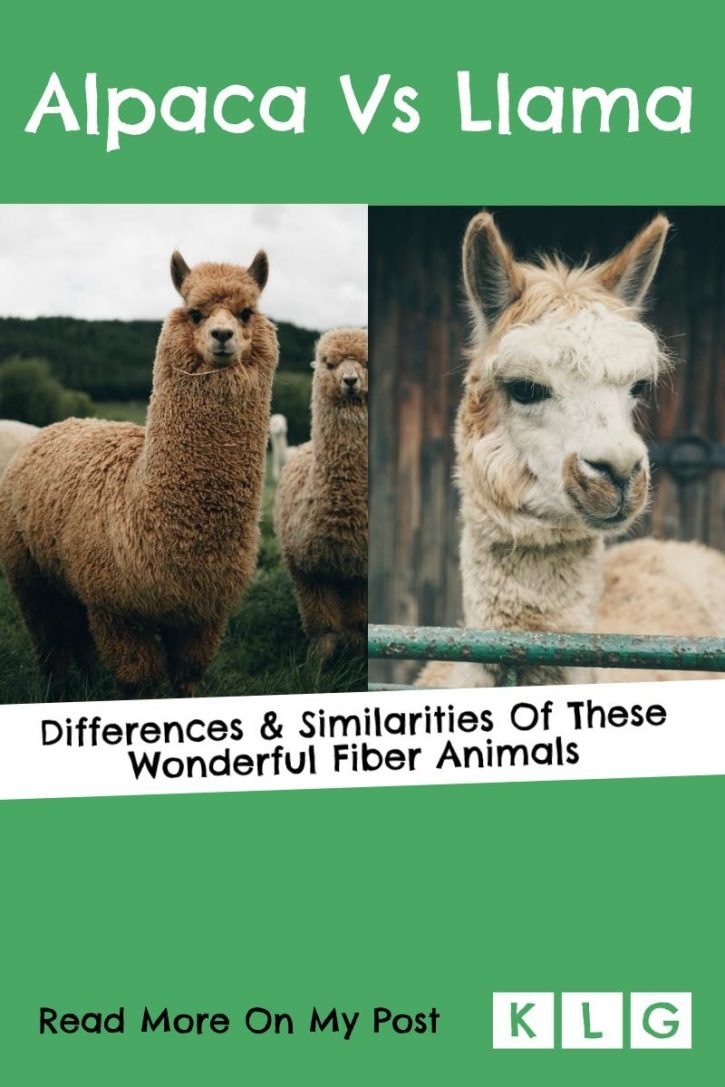Think Alpacas and llamas are the same animals? They’re from the same family, Camelidae, but they’re different creatures. To solve the mystery of alpaca vs llama, I describe their similarities and differences.

Great! One last step. Check your inbox for a confirmation email.
Llama vs Alpaca – 11 Differences
- Face – Alpacas – short/blunt | Llamas – long/pronounced
- Ears – Alpaca – short/spear-shaped | Llama – long/curved
- Height – Alpacas – 81-99cm | Llamas – 1.7-1.8m
- Fleece – Alpaca – fine/fluffy | Llama – short/coarse
- Body – Alpacas – short/rounded | Llamas – long/straight
- Purpose – Alpaca – fleece | Llama – pack animal/guard
- Spitting – Alpacas – hardly | Llamas – often
- Strength – Alpaca – weak | Llama – strong
- Behavior – Alpacas – social | Llamas – independent
- Temperament – Alpaca – timid | Llama – confident
- Weight – Alpacas – 150 lbs | Llamas – 400 lbs
Soon, you’ll know how to determine an alpaca and a llama!
I reviewed, fact checked and updated this post on May 22, 2023.
Table Of Contents
Important Note: There are four related animals. The alpaca, the llama, and their camelid cousins, vicunas, and guanacos. If you’re an alpaca farmer or llama farmer, you must have to deal with people confusing your animals all the time!
First thought to be domesticated by the Inca Empire, Machu Picchu, was a place for rearing these creatures. They’re still in and around Machu Picchu today! Despite being native to South America, there are 300,000 Alpacas and llamas in the United States. Alpacas live up to 4,500m above sea level – llamas, 5,500m.

Alpacas

Domesticated Alpacas are descendants of the wild South American ‘Vicuña,’ from the camelid family. It’s native to the central Andes. At first glance, they look indistinguishable from llamas, but there are differences!
Fun Fact: The scientific name of Alpacas is ‘Vicugna pacos.’ ‘Vicugna’ sounds like ‘vicuna,’ and vice versa.
In 1974, they were endangered. Poachers hunted them. There were 6000 left. Nowadays, their numbers have recovered to approximately 350,000. Their (camels) camelid cousin, Vicuñas, are smaller than alpacas and guanacos and are more delicate.

There are two breeds of alpaca, Suri, and Huacaya.
- Suri hair is long, straight, and tassel-like, a bit like dreadlocks. The hair grows toward the ground. Less than ten percent of the alpaca population are Suris.
- Huacaya has short, crimpy, and fluffy fleece. Though they look plump and rounded, their neck and body are slim underneath.
- Alpaca ears are short and shaped like spears.
- Their fur has shades from white to almost jet black.
- Lifespan of about 15-20 years.
Fun Fact: Huacaya fleece lacks lanolin, making it hypoallergenic.
Llamas

Llamas are a South American camelid related to the Guanaco. They’re believed to come from North America (around 40 million yrs ago). Three million years later, they migrated to South America because of the Great American Interchange.
In North America, around 10,000-12,000 yrs ago, camelids were extinct. They’ve been repopulating since 2007.
I visited a Llama and Alpaca farm in late 2021 in Australia, and I had the privilege of feeding an eight-month-old Llama! His name was B-B, and he was hungry!

Guanacos are larger than Vicuñas but smaller than llamas. They live in Peru, Chile, Ecuador, Patagonia in Argentina, and parts of Paraguay. Guanacos are one of the largest mammals on the continent.
After Vicuñas, llama fiber is precious. It’s soft and warm. They have long, skinny necks, big bodies, and a small gray long face with pointy banana-shaped ears. They’re heavy, up to 400 pounds.
The Similarities
These south American animals from the camel family may look indistinguishable. Llamas and alpacas have much in common, including
- They have the same origin
- Llama and Alpacas call the Andes Mountains region home, in central and South America.
- Have a variety of fur colors
- Herbivores (they eat grass and hay)
- Llamas and alpacas have lanolin-free fleece, unlike sheep
The Differences
Don’t worry if you thought they were the same thing! Here’s a list of the difference between Alpacas and llamas.
1 Facial Shape
These features are the easiest way to distinguish an alpaca from a llama. In short, while alpaca faces look squashed, llamas have long snouts. Alpacas’ faces are short, a blunt muzzle and snout, and are fluffy. The alpaca’s face has thick fur, on the head and neck.
Llamas have a longer face, like a kangaroo or horse, and prominent muzzles. Llamas have little hair on their heads but some on their necks.
2 Ear Shape
Llama ears are long, curved, and have ears shaped like bananas. These banana-shaped ears stick almost straight up out from the head. Alpaca have short ears, shaped like spears, with a point at the top.
3 How Tall (Average Body Sizes)
Full-grown llamas grow to around 1.7-1.8m tall. The alpaca stands at 81-99cm tall at the withers (shoulder area). A llama is a lot bigger than its cousin!
4. Hair
Llamas have short, coarse, double-coated hair. The undercoat is softer and more delicate, sometimes used for garments. The rough outer coat (llama fleece) is used for lead ropes, rugs, and wall hangings.
The Huacaya alpaca has thick, soft, crimped fleece. A soft fiber like sheep wool. Suri has silky dreadlock-like hair that grows toward the ground and is better suited for weaving. It’s much finer than an llama. Baby alpacas have super fine hair when their coats are shorn.
5 Body Shape & Appearance
Llamas have long, straight backs, better suited to carry packs. Alpacas have a more rounded, sloping body.

6 Purpose
For 5,000 years, people have bred alpacas and llamas. Llamas are transportation and pack animals. (Pack animals carry loads during long journeys on foot.) They have a lot of power and travel far with a heavy load without needing much water.
They’re sometimes used as a source of meat. Also, guards for livestock like sheep and something else. Alpacas are bred for their soft fleece or kept as a pet all over the world. They lead a life of leisure compared to the llama!
7 Spitting
Alpacas don’t spit often, but they spit at each other. Llamas spit at each other when showing they’re more dominant. Both rarely spit at humans.
8. Strength
Since llamas are used for carrying packs, they hold loads up to 25 – 30 percent of their body weight for 8 – 13 km. They protect themselves and ward off animals such as coyotes and feral dogs. They make excellent guard animals as they have a protective instinct.
Alpacas, however, cannot protect themselves. Some farmers use llamas to guard animals and to protect an alpaca herd.
9 Behavior
An alpaca is social. They’re herd animals. If separated from its alpaca herd, this herd animal would die from loneliness. They’re also timid around people.
A llama is independent and aren’t herd animals. They’re curious, quick to learn new things and approach humans without hesitation.
10. Temperament & Dispositions
The personality and disposition of a llama and alpaca are different. The average alpaca is skittish but gentle. They stay close to their herd. Some people teach them to do tricks, like a dog, and keep them as pets.
Llamas have more independent, curious, and confident personalities. Training both is easy if you raise them from birth, give them proper socialization, and take care of them. (Groups need about an acre of land.)
11 Weight & Size
- Llamas – 130-200 kg or 400 pounds.
- Alpacas – 48-84 kg or 150 pounds.
Pin Now to Save for Later

Fibers
Llamas
They have a fine undercoat and a coarser outer coat. The undercoat is much softer, used for handicrafts and clothes. The outer coat is rough, with a scratchy feel, and is used for ropes and rugs. Llama fiber is lightweight but warm.
Alpacas
There are two types, the Huacaya and the Suri. The Huacaya Alpaca fiber is crimpy, warm, elastic, and hypoallergic. It’s used for knitting and crochet. For things like apparel, clothing, scarves, and more.
Suri Alpaca fiber doesn’t have a crimp and is suited to weaving. The wool from the first shearing is the finest and is called baby alpaca. Their wool creates a higher quality yarn than llamas. They’re even softer and warmer than cashmere!
If you knit, treat yourself to an alpaca sweater. You’ll wonder what you were missing!
More Fun Facts About Alpacas & Llamas
- Alpaca wool is water and flame resistant.
- Peru, Bolivia, and Chile have the largest number of Alpacas.
- Alpacas have padded feet. They tread lightly, not damaging pastures.
- Both don’t have top front teeth. They snip the grass, not ripping the grass out, including its roots.
- A Llama communicates by humming.
- Some communities and owners use their milk!
- Alpaca milk has the same lactose, protein, and fat as cow milk. Llama milk has more calcium and protein.
- However, both are harder to milk than cows and goats.
- Alpacas have excellent bathroom etiquette. The herd all place their poop in one spot. It’s easier for the farmer to collect fertilizer for their garden
- Vicuna fiber is one of the most valuable natural fibers ever!
- Llama poop has no odor.
- Many people have businesses where they have handmade products from Alpaca and Llama wool
- Like ponchos, hats, scarves, socks, sweaters, blankets
FAQS About Alpaca Vs Llama
Are Llamas Or Alpacas Friendlier?
It depends on the individual animal, but alpacas are friendlier. Llamas are more aggressive and suspicious of strangers.
Do Alpacas Or Llamas Spit At You?
Sometimes Alpacas and Llamas spit at you. Despite their sweet nature, they’re prone to spitting as a defensive mechanism. They sometimes spit without provocation.
Why Alpacas Are Better Than Llamas?
In terms of temperament and fiber characteristics, Alpacas are better than llamas. Each species is valuable in different ways.
Are Llamas More Aggressive Than Alpacas?
Yes, Llamas have a desire to protect and exert their dominance.
How Closely Related Are Llamas And Alpacas?
They’re camelids, making them similar.
Does Peru Have Llamas Or Alpacas?
Peru has llamas and Alpacas! Both animals are native and have been a part of the local customs and history for a long time. Cusco has a large population.
Conclusion
Do you work with Alpaca wool, or have you worked with Llama wool? Have you learned anything about these animals? I’d love to hear your thoughts.
Read Next: Want to learn more about the topic? Read my post for knitting bloggers who work with the yarn from these animals, or my interview with the hosts of the Great Northwest Fiber Fest, who talk about one of their vendors, an alpaca farmer.

I love knitting with baby alpaca yarn, it is super soft and squooshy. Alpacas are just the most adorable animals.
Hi Louise. I love baby alpaca too! Accidentally washed my baby alpaca wool scarf in the washing machine. It felted. A lesson learned! Yes, they have such gorgeous faces. 🙂